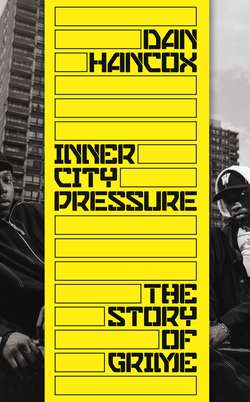Inner City Pressure: The Story of Grime

Реклама. ООО «ЛитРес», ИНН: 7719571260.
Оглавление
Dan Hancox. Inner City Pressure: The Story of Grime
Copyright
Dedication
Contents
DON’T HOLD HIM BACK!
THE CITY AND THE CITY
IN THE ROOTS
THE NEW ICE AGE
THE LAST OF THE PIRATES
THE MAINSTREAM AND THE MANOR
GRIME WAVES AND THE RESPECT AGENDA
NEIGHBOURHOOD NATIONALISM
SHUTDOWN
DIY AND REDEMPTION SONGS
WE RUN THE STREETS TODAY
GENTRIFICATION AND THE MANOR REMADE
A TRUE URBAN RENAISSANCE
THE REAL PRIME MINISTERS
BACK YOUR CITY
Notes
Acknowledgements
List of Images
Index
Also by Dan Hancox
About the Author
About the Publisher
Отрывок из книги
Title Page
.....
One Canada Square, the actual name of the fifty-storey, pyramid-topped building often identified as ‘Canary Wharf’, was completed in 1991, and became the UK’s tallest building, the most visible legacy of Thatcherism, towering over London. It was not until the first years of the new millennium that Canary Wharf really fulfilled its destiny as ‘the second City’, and took on a life of its own, outstripping the old City of London (the capital’s traditional financial centre, around Bank and St Paul’s, with its antiquated heraldry, liveries and rituals), and becoming the home of the newer, much more dangerous unregulated financial speculation that would be instrumental in creating the global financial crisis of 2008. Peter Gowan called it ‘Wall Street’s Guantánamo’, a lawless bolt-hole where firms like Lehman Brothers could get away with complex debt-repackaging and trading they would never have been allowed to pursue in Manhattan.7
In a neat example of the laissez-faire capitalism which led to the financial crisis itself, the building of Canary Wharf itself benefited from special government exemptions on rates, tax and a speeded-up planning permission process. No questions and no regulations. It was to be the Big Bang of urban regeneration – creating not just the bankers’ skyscrapers that watched over the grime kids, the yin to the estates’ yang, but also a new airport aimed at business-class customers (London City Airport, opened 1987), the Docklands Light Railway (1987), the Jubilee Line Extension (1999) and the ExCeL conference centre (2000). The LDDC was the flagship of the hyper-gentrification that would follow across British cities, legitimising New Labour’s urban renaissance, of which the renovating and demolishing of council estates was also a vital part. Canary Wharf’s tower blocks were barely a couple of miles from the council blocks where the pirate radio aerials were going up, but ‘the second City’ was never designed to have a relationship with its neighbours: the attention was turned towards its rival and parent. Canary Wharf was deliberately laid out so its ‘central axis’ – a gap in the two tower blocks facing One Canada Square – looks out across a fountain, and lines of trees, towards the City of London.
.....